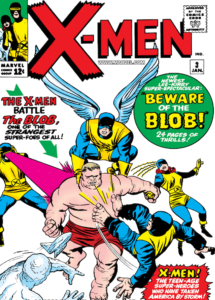
An Introduction;
Or: Lemon Tree
“I’m sitting here in a boring room
it’s just another rainy Sunday afternoon
I’m wasting my time, I got nothing to do
I’m hanging around, I’m waiting for you
but nothing ever happens, and I wonder”
(Fool’s Garden)
 The idea for this column was born back at the beginning of 2017. I was studying media science and philosophy in my third semester, and in my major – media science – every student needs to do a so-called “project study.” This project is meant to be a scientific and practical project, where you create something on your own. You focus on one aspect or one topic, but always keep the scientific side in mind. I consider myself a blogger and writer and I, therefore, was eager to do a series of blog articles.
The idea for this column was born back at the beginning of 2017. I was studying media science and philosophy in my third semester, and in my major – media science – every student needs to do a so-called “project study.” This project is meant to be a scientific and practical project, where you create something on your own. You focus on one aspect or one topic, but always keep the scientific side in mind. I consider myself a blogger and writer and I, therefore, was eager to do a series of blog articles.
The following months, after I had the idea, I talked to Prof. Dr. Tanja Thomas, a professor in the media science department, and asked her if she would be interested in overseeing the project. After a rich discussion of how to realize my idea, I did a lot of research and began to read some X-Men comics. The results of my research and readings you can see right now or better, you will see them, once the main articles are being released. I hope you enjoy the articles. I sure had a lot of fun writing them (and still have). You could say, that this journey was an incredible Xperience. An Xcellent idea, you might say.
Where to begin?
I love comics, and I consider myself a big fan of the X-Men. Unfortunately, my experience with them was somewhat limited. My first real encounter with any X-Men was the first film by Bryan Singer back in 2000. I was eleven years old at that time and was instantly fascinated. Since then I watched every movie and read some comics of these wonderful characters. Still, they stayed in the background, and I never dedicated myself to read them as a whole – mostly because I didn’t know where to begin. If you look at this graph from the doctoral dissertation “Reading The Uncanny X-Men: Gender, Race and the mutant metaphor in a popular narrative” by Joseph Darowski, you can see just how many series there were, and still are.

Granted since 2011 there were like 50 events, ten all-new all-different restarts and a bunch of mini-series, as well as specials, that had the potential to “break the internet” as Marvel stated mid-2017. However, all this is now, and what we want to do is go back in time, to the good-old-times. You know, when comics cost just a few cents, and Stan Lee and Jack Kirby created more than half of our heroes we know and love to this day. That is where our journey begins.
I always wanted to read the X-Men from the very beginning and Xperience the stories as a whole. Where did they start, what happened along the way and finally understand all the references that can still be found in today’s issues and movies. Unfortunately, as I discovered this great reading list from comicvine, I realized, there are a lot of X-Men comics. You could read hundreds, and hundreds of issues and still be behind because new ones are release month after month after month. That’s discouraging. But I don’t give up, and so I made some cuts. I mean, I have to begin somewhere, right?
The Plan
The project has to have an end – at least the counseled part related to the media science study has. And it should be done before my sixth semester so that I can focus on my bachelor thesis then. I decided to do a series of about 15 articles (this introduction included). Of course, I will continue with the series, if I want to and if you want to read more about the X-Men. To make it a bit more interesting, I took different creator runs from the past five decades and this is the list that finally made it into my series:
- Stan Lee / Jack Kirby (1963-1966)
- Roy Thomas / Neal Adams (1969/70)
- X-Men First Class v1 (2007)
- Chris Claremont Part I
- Chris Claremont Part II
- Chris Claremont Part III
- Avengers Disassembled (2004/2005)
- House of M
- X-Men Legacy: Legion (2-part review)
I don’t want to talk about the X-Men solely, that would just be a couple of in-depth reviews of some comics, and I already wrote a lot of reviews for the past x years. Instead, I wanted to take it a bit further. I came up with the idea, to take something from those runs – a topic, theme or idea – and talk about it in more detail in a separate article. Those subjects could be anything from the Comic Book Authority to comic book studies in general, about terminology, interesting debates, philosophies that are mentioned, or explanations of sexual orientations and gender-concepts.
That means that every review/analysis is followed by a more theoretical based article – an essay. These are the topics I chose so far:
- Comic Book Authority
- What is a mutant?
- the ages comic books
- the mutant metaphor
- Philosophies within the X-Men
- A broken back in the refrigerator
- comic book events
- Who am I?
The thing about the X-Men and their very long history is that they are often viewed as this conglomerate of ideas, and themes. Therefore creators are themselves often seen as an agglutinated mass. But they are not. Every creator has to be read separately and therefore be analyzed as a constituent component of the big picture, that is the X-Men. It is a mistake to create a universal image of the x-universe.
Another important thing is that every individual, with his or her cultural background, interprets things differently. With my research, I tried to cope with that limitation. Please keep in mind: my articles are just one way to see it, one way to interpret things, inspired by the books and articles I will mention. If you think I forgot something, please feel free to comment, and we can hopefully have a vibrant discussion about it.
What’s Left to Say
 Bear in mind, that Chris Claremont is mentioned more often because he wrote the X-Men for nearly 20 years in many different team- and solo-series’. Therefore he shaped the X-Men like no one before or after. At first, I thought I would pick just some story-arcs here and there. But that seemed impossible. How could I, as an outsider, choose the “right” ones? I mean, his stories are the best stories of the X-Men, like The Dark Phoenix Saga, Days of Future Past, Trial of Magneto or The Fall of the Mutants. And I don’t want to read those stories without any background information or no knowledge of what happened so far. What I want to say is: We will go through his run chronologically, based on the reading order I mentioned above.
Bear in mind, that Chris Claremont is mentioned more often because he wrote the X-Men for nearly 20 years in many different team- and solo-series’. Therefore he shaped the X-Men like no one before or after. At first, I thought I would pick just some story-arcs here and there. But that seemed impossible. How could I, as an outsider, choose the “right” ones? I mean, his stories are the best stories of the X-Men, like The Dark Phoenix Saga, Days of Future Past, Trial of Magneto or The Fall of the Mutants. And I don’t want to read those stories without any background information or no knowledge of what happened so far. What I want to say is: We will go through his run chronologically, based on the reading order I mentioned above.
I think that’s enough for now. As for the release schedule: I am going to release two articles per month. So every month has a theme and this way you will have enough time to read the issues as well. Marvel Unlimited is a good place to start, but if you are a collector, there are beautiful but expensive Omnibus and Collectors Editions as well. Currently, I am reading them digitally, but once there is more money in my bank account I want some of the collections as well.
Along the way, I also might have some surprises for you: additional articles and reviews about certain aspects or incarnations of the X-Men. But for now:
See you in February. Then we will talk about the Kirby and Lee run (X-Men #1 to #19)




2 thoughts on “Everything X-Men: Introduction”